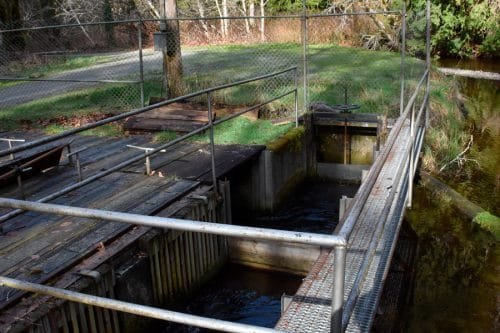 Intakes at Minter Creek Hatchery will be rebuilt with state funds. Photo: Don Tjossem, KP News
Intakes at Minter Creek Hatchery will be rebuilt with state funds. Photo: Don Tjossem, KP News
Approval of the state capital budget last month was good news for the Minter Creek Hatchery. The water intake system, which ensures that incubating eggs and growing salmon can thrive, will get a much-needed upgrade thanks to a $6.5 million grant.
The Minter Creek Hatchery, established in 1936, raises millions of salmon each year for release into Puget Sound. Chinook, coho and chum salmon are all part of the program, which is designed to protect endangered species (the spring chinook) and enhance salmon populations for fishermen and the tribes (fall chinook, coho and chum).
The two intakes, which bring water from Minter Creek into the hatchery, were built in 1962. Gravity powers the upstream system, where water flows from a holding pond created in a deep portion of the creek by a dam. The lower intake, at the same elevation as the hatchery, uses a pump to collect water in a vault.
Screens at the start of the intakes block debris and fish. Sediment from the stream should flow from the creek into Puget Sound to provide important nutrients, but the current system allows more sediment into the fishponds than the staff can clear. This decreases the space available for water and limits room for fish.
The project will include evaluation of the intake pipes, replacement of the screens and rebuilding of a dam and settling ponds to allow sediment to both flow downstream and settle naturally in the creek before water enters the hatchery.
The diameter of the current screens could allow young fry to pass through. “The rebuild will bring us into compliance with NOAA regulations for screen size,” said Deirdre Bissonnette, manager of the hatchery. “This will have a positive impact on naturally spawning populations in the creek, as they are the ones exposed to the intake.”
The upstream system includes a dam, which creates a deep area in the creek and feeds the intake pipe. It can get clogged, and the new dam will have better infrastructure and technology to keep the sediment load moving. Water will then flow from the intake pipe into a settling pond, allowing suspended dirt to settle out before entering the hatchery.
The lower system flows from the creek, is screened and then enters a vault before going to the ponds. The new plan will move the intake upstream to a deeper spot in the creek, which will allow the sediment to settle before entering the vault.
Plans to request the upgrade started at least two years ago, Bissonnette said. Now that funding has been approved, design and permitting will take place over the next few years, she said, with bids for construction to go out in early 2020 and construction ideally occurring in the summer of that year.
UNDERWRITTEN BY THE FUND FOR NONPROFIT NEWS (NEWSMATCH) AT THE MIAMI FOUNDATION, THE ANGEL GUILD, ADVERTISERS, DONORS AND PEOPLE WHO SUPPORT INDEPENDENT, NONPROFIT LOCAL NEWS